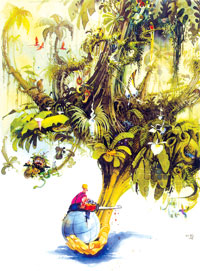|
|
Among the things that we can be justifiably proud of is Nepal's track record in nature conservation.
Whether it was during a dictatorial monarchy or a messy democracy, in times of peace or war, our national parks and nature reserves became international show cases. The success story of Chitwan's people-park initiative, the eco-tourism model to fund grassroots development in the Annapurnas and the success in melding trekking with environmental protection in Sagarmatha National Park are now recognised by experts the world over.
Nepal suffered a national tragedy when we lost most of our top environmentalists in a helicopter crash in September 2006 at Ghunsa in the Kangchenjunga area. Among them was Tirtha Man Maskey, the architect of Chitwan's people-park concept, Mingma Norbu, who made the Sagarmatha eco-tourism model work. Chandra Gurung, the man behind the Annapurna tourism-for-development project.
The country will take a long time to recover from that momentous loss. But it is a tribute to the people who masterminded them that the projects worked so well for so long.
Another reason our national parks still have tigers has been the involvement of the army to guard them. The Maoist conflict led to the redeployment of army units from national parks, and resulted in a dramatic increase in poaching and encroachment in the tarai parks.
Since 2003, 165 rhinos have been killed for their horns in Chitwan and another 72 translocated rhinos have been poached in Bardia. No one knows how many tigers have been killed.
In Chitwan, the army outposts closed down during the war have been re-established, but in Bardia, Sukla Phanta and Kosi Tappu this process has been slow.
Another fallout of democracy has been the conversion of the King Mahendra Trust for Nature Conservation into the National Trust for Nature Conservation. The former was run like a royal fiefdom and there is evidence of gross mismanagement in the past. Despite this, the Trust was working to replicate the Annapurna project in Kangchenjunga and Manaslu.
The Trust's name has changed and it has been transferred from the royals to the Maoists who have turned the organisation into an employment centre for the YCL. Saving wildlife and protecting the environment doesn't come easily to comrades who had no qualms about killing human beings.
But here is one area where the Maoists don't have to destroy in order to rebuild. We have proven expertise in promoting rural development not by extorting tourists, but through park fees. We have shown how villagers in the buffer zones can actively help protect nature.
The Maoists are trying to portray themselves as water-melons, green on the outside and red inside. But they shouldn't throw away concrete achievements of the old Nepal for the vague notion of a new Nepal.



